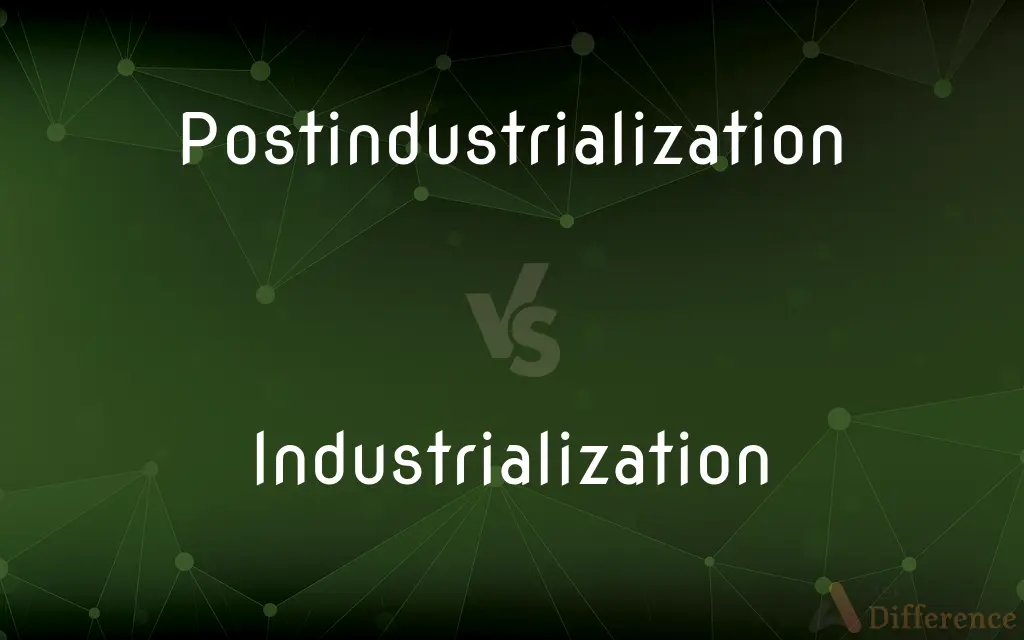Postindustrialization vs. Industrialization — What's the Difference?
Edited by Tayyaba Rehman — By Urooj Arif — Updated on March 25, 2024
Postindustrialization emphasizes service and technology sectors, while industrialization focuses on manufacturing and mechanization.

Difference Between Postindustrialization and Industrialization
Table of Contents
ADVERTISEMENT
Key Differences
Industrialization marks a period where economies transition from primarily agricultural to manufacturing and industrial activities. This phase is characterized by the introduction of machinery, increased production, and urbanization. On the other hand, postindustrialization signifies a shift from manufacturing-based economies to those dominated by services, information technology, and knowledge sectors.
During industrialization, the workforce predominantly moves from agriculture to factories, leading to urban migration and the growth of cities. Whereas in the postindustrial phase, there's a significant increase in white-collar jobs, and the workforce is more engaged in services, research, and technology sectors.
Industrialization is often associated with the exploitation of natural resources and a significant environmental impact due to heavy manufacturing and pollution. In contrast, postindustrialization tends to have a reduced direct environmental impact as economies move away from heavy manufacturing to more service-oriented and technology-driven industries.
The era of industrialization brought about significant advancements in transportation, such as railways and steamships, which facilitated the movement of goods and people. Postindustrialization, however, is marked by advancements in information and communication technologies, with the internet and digital platforms transforming how services are delivered and consumed.
Socially, industrialization led to the rise of a working class, labor unions, and often harsh working conditions. Postindustrial societies, however, see a more diversified employment landscape, with greater emphasis on education, professional services, and knowledge-based occupations.
ADVERTISEMENT
Comparison Chart
Focus
Services, information, and technology
Manufacturing and mechanization
Key Industries
IT, finance, and healthcare
Textiles, steel, and coal
Workforce Movement
From manufacturing to services and tech sectors
From agriculture to factories
Environmental Impact
Lower, shifting away from heavy industry
High due to manufacturing and pollution
Technological Advancements
Internet, digital communication
Railways, steam engines
Compare with Definitions
Postindustrialization
Characterized by the dominance of the service sector and knowledge-based industries.
In postindustrial societies, more people are employed in sectors like IT and healthcare than in manufacturing.
Industrialization
The process of developing industries in a country or region on a wide scale.
The industrialization of Europe in the 19th century transformed rural societies into urban ones.
Postindustrialization
Leads to changes in workforce skills, emphasizing education and professional expertise.
Postindustrialization has increased the demand for higher education and specialized skills.
Industrialization
Characterized by the introduction and reliance on mechanized production.
The cotton gin was a key invention that accelerated industrialization in the textile industry.
Postindustrialization
The evolution of an economy from one based on industrial manufacturing to one focused on services and technology.
Postindustrialization has led to the growth of the tech industry and a decline in manufacturing jobs.
Industrialization
Associated with the growth of factories and increased labor specialization.
Industrialization brought about the rise of factory towns and significant workforce shifts.
Postindustrialization
Associated with the rise of the information economy and digital technologies.
The advent of the internet has been a driving force in postindustrialization.
Industrialization
Transition from an agricultural economy to one based on the mass production of goods.
Industrialization led to significant social and economic changes, including urbanization.
Postindustrialization
May result in reduced environmental degradation compared to industrial periods.
The shift towards a service-based economy in postindustrialization has lessened some forms of environmental pollution.
Industrialization
Often accompanied by environmental challenges due to industrial emissions.
The early phases of industrialization were marked by significant air and water pollution.
Postindustrialization
The period marked by decline in industrialization and a social movement from blue-collar to white-collar jobs.
Industrialization
To develop industry in (a country or society, for example).
Industrialization
To organize (the production of something) as an industry.
Industrialization
To become industrial.
Industrialization
A process of social and economic change whereby a human society is transformed from a preindustrial to an industrial state.
Industrialization
The development of industry on an extensive scale
Common Curiosities
What is industrialization?
Industrialization is the transformation of an economy from primarily agricultural to one focused on the manufacturing and production of goods.
What industries are prominent in postindustrial societies?
Information technology, finance, healthcare, and other service-oriented sectors dominate postindustrial societies.
What are the environmental impacts of industrialization?
Industrialization often results in significant environmental degradation due to pollution from manufacturing processes.
What technological advancements are associated with industrialization?
The development of steam engines, railways, and mechanized production techniques are key technological advancements of industrialization.
How did industrialization impact urban development?
Industrialization led to rapid urbanization as people moved to cities for factory jobs, significantly altering social and economic structures.
How does industrialization affect the workforce?
Industrialization typically leads to a workforce shift from agriculture to factories, emphasizing mechanized production.
What is the role of education in postindustrial societies?
Education becomes increasingly important in postindustrial societies, with a focus on higher education and specialized skills.
How does postindustrialization influence employment trends?
Postindustrialization shifts employment towards white-collar jobs in service, technology, and knowledge-based sectors.
What key technologies define postindustrial societies?
Digital communication, the internet, and advanced information technologies are central to postindustrial societies.
Can industrialization and postindustrialization coexist?
Yes, some aspects of industrialization can persist in a predominantly postindustrial economy, especially in developing countries.
What defines postindustrialization?
Postindustrialization is characterized by an economy's shift from manufacturing-based industries to those centered on services, information, and technology.
What social changes are brought by postindustrialization?
Postindustrialization brings a more diversified employment landscape, with greater emphasis on education and professional services.
Did industrialization improve living standards?
While industrialization led to economic growth and some improvements in living standards, it also resulted in significant social and environmental challenges.
What are the challenges of transitioning to a postindustrial economy?
Challenges include managing workforce transitions, ensuring equitable access to education, and addressing the remnants of industrial environmental impact.
How does postindustrialization affect global economies?
Postindustrialization leads to a more interconnected global economy, emphasizing information exchange and technology.
Share Your Discovery

Previous Comparison
Escaper vs. Escapee
Next Comparison
Derringer vs. PistolAuthor Spotlight
Written by
Urooj ArifUrooj is a skilled content writer at Ask Difference, known for her exceptional ability to simplify complex topics into engaging and informative content. With a passion for research and a flair for clear, concise writing, she consistently delivers articles that resonate with our diverse audience.
Edited by
Tayyaba RehmanTayyaba Rehman is a distinguished writer, currently serving as a primary contributor to askdifference.com. As a researcher in semantics and etymology, Tayyaba's passion for the complexity of languages and their distinctions has found a perfect home on the platform. Tayyaba delves into the intricacies of language, distinguishing between commonly confused words and phrases, thereby providing clarity for readers worldwide.
















































